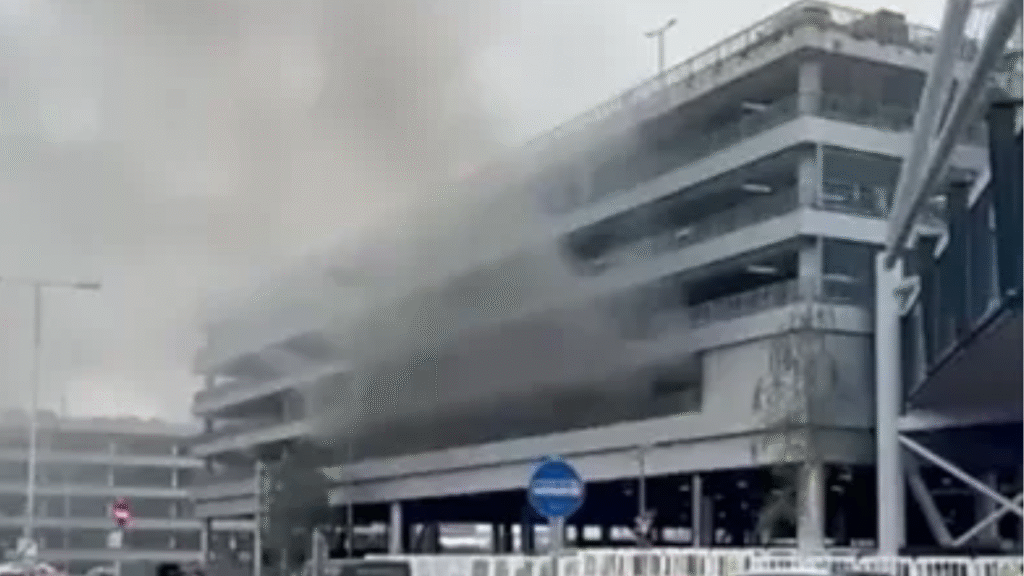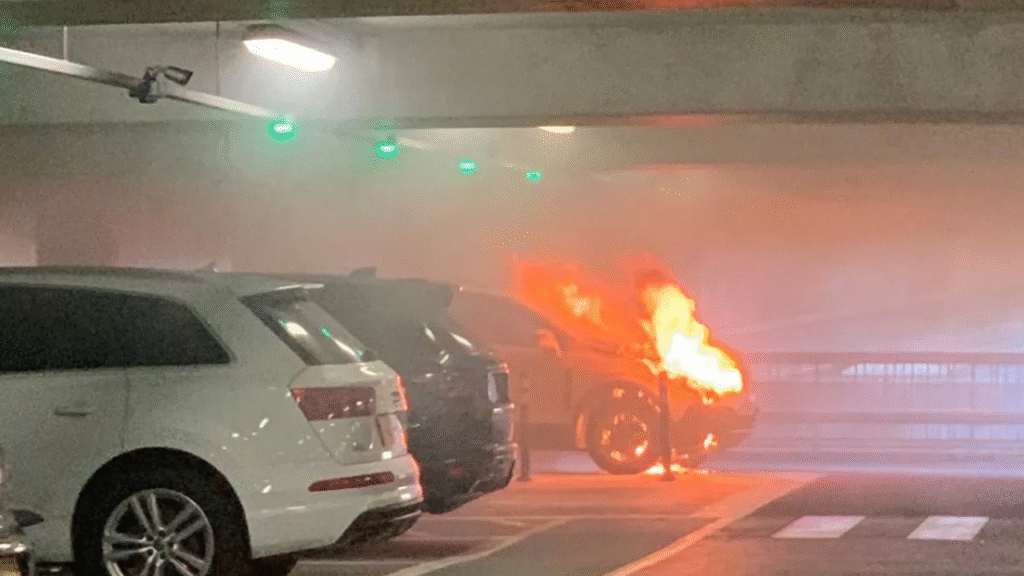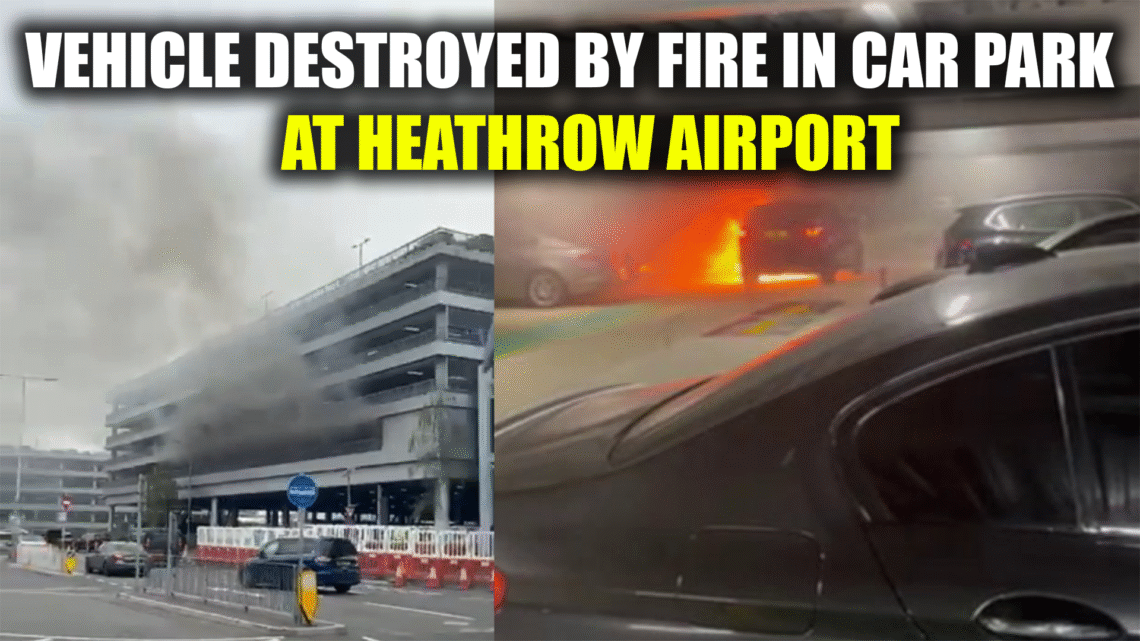On the morning of October 1, 2025, a vehicle caught fire and was completely destroyed in a multi-storey car park at Heathrow Airport’s Terminal 3. The blaze caused delays and disrupted traffic for passengers and staff. Fortunately, firefighters acted quickly, and no one was injured. This incident emphasizes the importance of safety measures in busy airport parking areas.A Heathrow car park vehicle fire destroyed a car on the morning of October 1, 2025, causing major disruption for passengers and staff. Firefighters acted quickly, and no one was injured. The incident highlights the importance of safety measures in busy airport parking areas.

Incident Overview
Timeline of Events
- 9:04 AM: The London Fire Brigade received a report about a car fire at Terminal 3.
- 9:30 AM: Firefighters arrived with four engines and began extinguishing the fire.
- 10:06 AM: They controlled the blaze, preventing it from spreading to other vehicles.
- 11:00 AM: Authorities reopened the car park after conducting safety checks.
Affected Areas
- Car Park: The vehicle was completely destroyed, and two nearby cars sustained minor damage.
- Access Routes: The road tunnel linking Terminals 1, 2, and 3 temporarily closed, causing traffic congestion.
- Public Transport: Arriva’s 724 bus service rerouted to Terminal 5, bypassing Greenways and Lees Road.
Causes of Vehicle Fires in Airport Car Parks
Several factors can trigger vehicle fires in busy airport parking areas:
Mechanical Failures
Overheating engines or faulty wiring often ignite flames. Therefore, regular servicing reduces this risk.
Electrical Malfunctions
Short circuits, damaged cables, or battery issues in electric or hybrid vehicles can spark fires.
Fuel Leaks
Even a minor fuel leak can ignite when combined with heat.
Human Negligence
Passengers leaving flammable materials inside vehicles or ignoring maintenance issues contribute to fire risks.
Safety Measures and Airport Responses
Airport Protocols
Heathrow Airport implements several safety measures:
- Fire Suppression Systems: Sprinklers and extinguishers are installed throughout car parks.
- Routine Inspections: Staff conduct regular safety checks of parking structures and equipment.
- Emergency Procedures: Clear signage and evacuation routes help guide passengers during incidents.
Fire Brigade Actions
- Rapid Deployment: Firefighters arrived quickly with sufficient resources.
- Containment: Crews controlled the fire efficiently, preventing it from spreading.
- Post-Incident Assessment: Fire teams evaluated the car park’s fire safety systems.
Impact on Passengers and Operations
Passenger Disruptions
- Delayed Access: Passengers faced delays reaching terminals due to temporary road closures.
- Stress: Smoke and flames caused anxiety among travelers.
- Flight Check-In: Some travelers experienced late check-ins due to congestion.
Operational Challenges
- Resource Allocation: Staff managed the incident while maintaining airport operations.
- Communication: Officials updated passengers via announcements and apps.
- Infrastructure Checks: Authorities ensured the car park remained structurally sound.
Lessons Learned and Preventive Measures
Vehicle Maintenance
- Regular Servicing: Timely maintenance prevents mechanical failures.
- Battery Inspections: Checking electric vehicle batteries reduces fire risks.
Public Awareness
- Safety Campaigns: Airports and media can educate the public about fire hazards.
- Emergency Procedures: Informing travelers about evacuation plans improves safety.
Infrastructure Improvements
- Enhanced Fire Suppression: Sprinklers, extinguishers, and smoke detectors can reduce fire damage.
- Clear Signage: Proper labeling of exits and fire equipment improves response times.
Real-Life Case Study: Luton Airport Fire (2023)
In 2023, a fire at Luton Airport’s multi-storey car park destroyed over 1,500 vehicles. Investigations revealed that a diesel car fire spread quickly due to insufficient fire suppression. This case demonstrates how one small fire can escalate if safety measures are inadequate.
Strategies for Travelers
- Arrive Early: Allocate extra time in case of delays caused by incidents.
- Follow Updates: Check airport apps or social media for real-time information.
- Keep Insurance Documents Handy: Quickly file claims if your vehicle sustains damage.
- Use Alternative Transport: Shuttle buses or taxis can bypass closed car park sections.
FAQs
1. Was anyone injured in the Heathrow Airport car park fire?
No injuries occurred. Firefighters evacuated the area safely.
2. What caused the vehicle fire at Heathrow Airport?
The exact cause is under investigation, but mechanical failure, electrical issues, or fuel leaks are likely contributors.
3. How can travelers prevent car fires?
Maintain vehicles regularly, avoid leaving flammable items, and park responsibly.
4. What safety measures exist in Heathrow car parks?
Sprinklers, smoke detectors, regular inspections, and emergency protocols ensure passenger safety.
5. Has Heathrow Airport had similar incidents before?
While rare, car park fires have occurred, prompting continuous improvements in safety and public awareness.

Conclusion
The vehicle destroyed by fire in a car park at Heathrow Airport highlights the importance of vigilance and safety measures in busy parking areas. Quick response from firefighters prevented further damage, while airport staff ensured passenger safety. Travelers must maintain vehicles properly, remain alert, and follow emergency procedures. Similarly, airports need to invest in robust infrastructure, regular inspections, and public awareness campaigns. By combining preparation and proactive safety measures, such incidents can be minimized, ensuring safer travel experiences for everyone.





